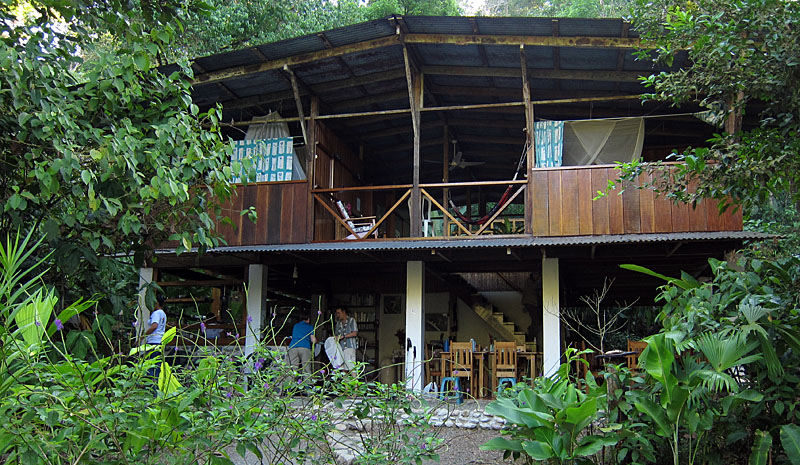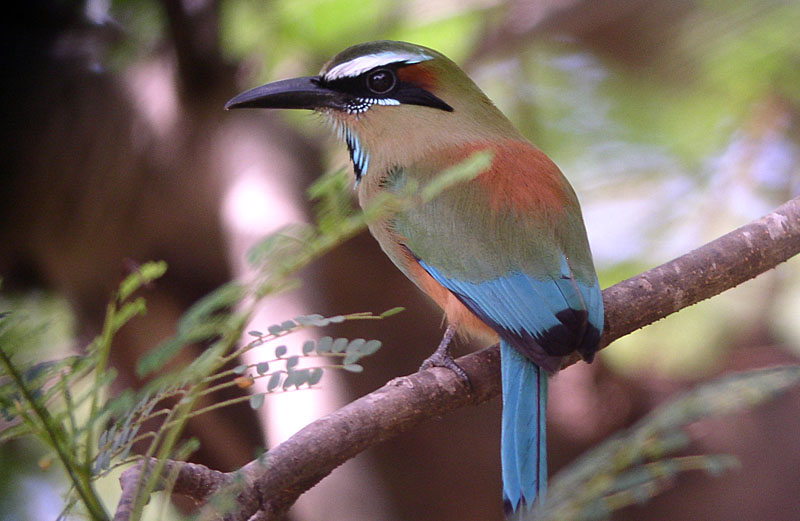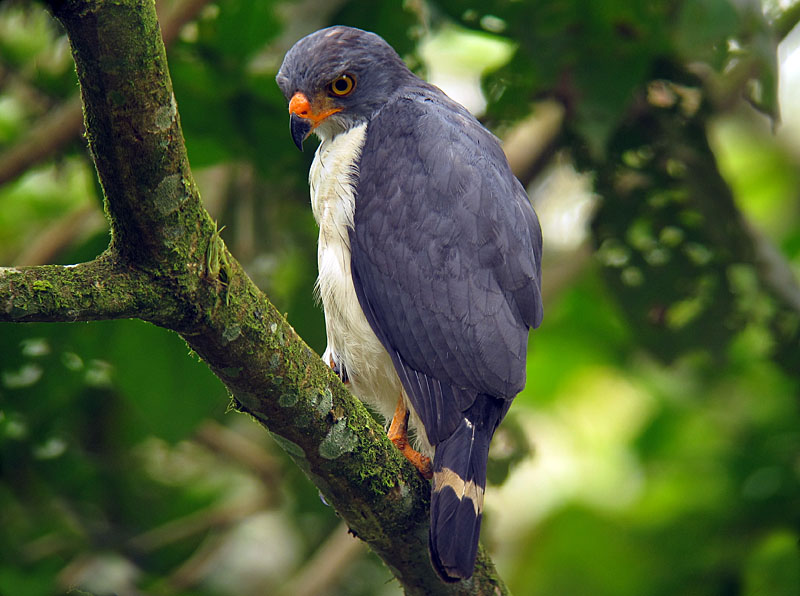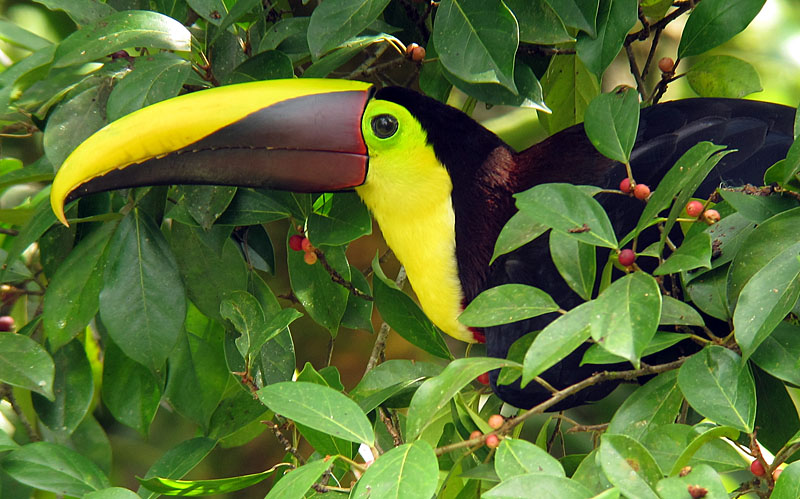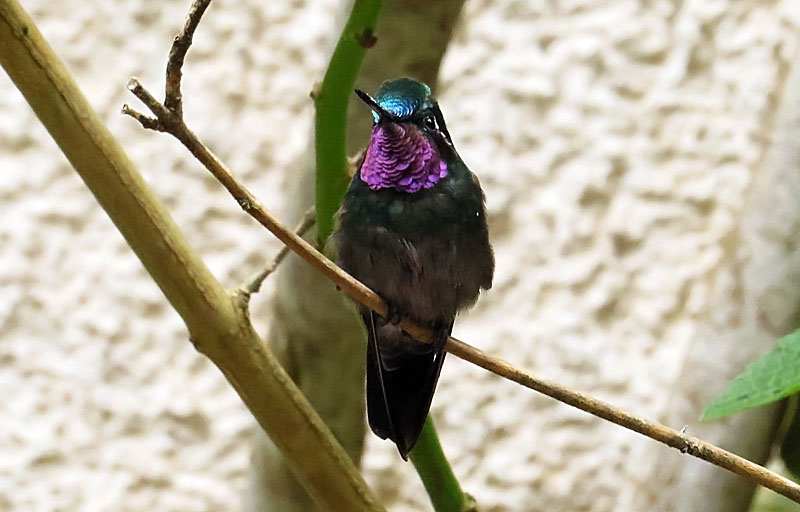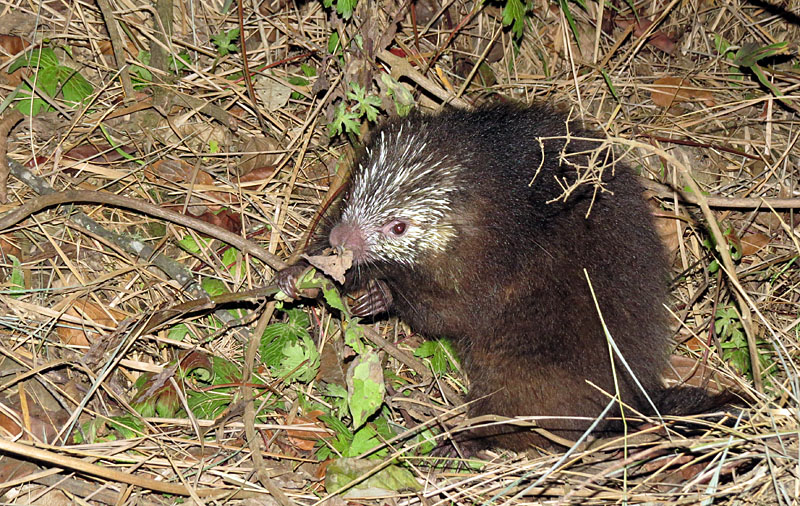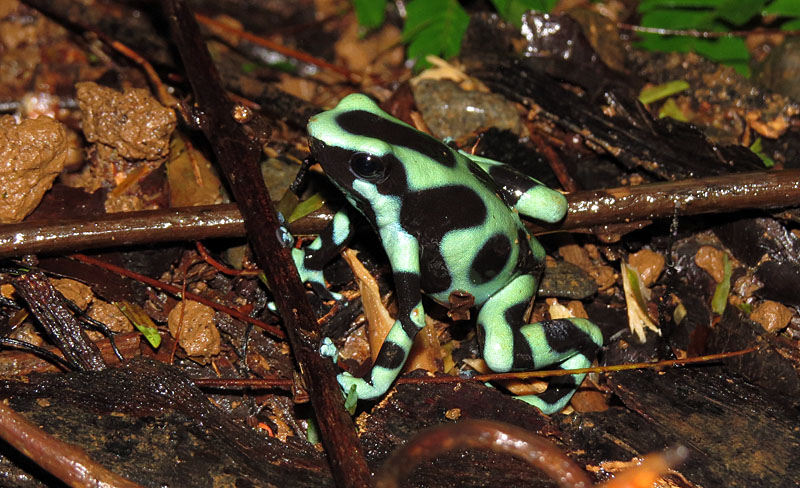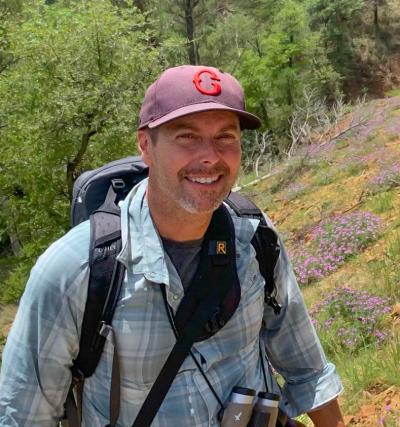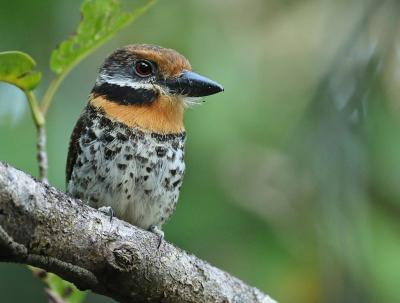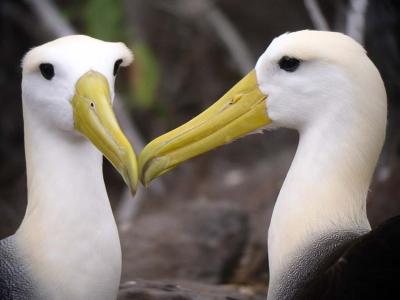Costa Rica in Spring
-
Feb 21 to Mar 7 2025
Rich Hoyer
-
Feb 27 to Mar 13 2026
2026 Tour Price to be Determined
2026 Tour Price to be Determined
With an area of less than 20,000 square miles, Costa Rica is the third-smallest nation in Central America. But in proportion to the country’s size, its avifauna, comprising nearly 900 species, is among the richest in the world. For the visiting birder, this modern and politically stable country presents the obvious advantage of compactness combined with excellent hotels and lodges, delicious food, stunning scenery, friendly people, and fantastic birding. Our tour concentrates on the best birding areas, from the oak forests of the Talamanca Highlands with its many endemics and Resplendent Quetzals, to the rich Osa Peninsula in the Pacific lowlands, the stunning cloud forest at Monteverde, and the Caribbean lowlands, where we’ll stay at a resort with very birdy grounds near La Selva Biological Station and Braulio Carrillo National Park. We should see more than 400 species over our 13 days of birding.
Day 1: The tour begins at 6 pm this evening in the lobby of our hotel. Night in Heredia.
Great tour. Rich Hoyer is a savant with birds (and other wildlife) and is worth the money just to watch. -William H.
Day 2: The Central Valley, where we begin our tour, is bounded to the east by the Cordillera de Talamanca, a vast mountain range protected in national parks or biological preserves. One national park, Tapantí-Macizo Cerro de la Muerte, is only a short distance from San José, and we’ll spend the whole morning exploring its lush cloud forest. Here we’ll have our first chance at many montane forest species such as Black Guan, White-bellied Mountain-gem, Collared Trogon, Prong-billed and Red-headed Barbets, Golden-bellied Flycatcher, Torrent Tyrannulet, and Spangle-cheeked and Bay-headed Tanagers. Several species otherwise rare in Central America are seen regularly at Tapantí, including Green-fronted Lancebill, Silvery-fronted Tapaculo, and Wrenthrush. In the afternoon we’ll continue to our hotel, where the garden drips with blooming fuchsias and begonias in a high mountain valley below Cerro de la Muerte. Night in San Gerardo de Dota.
Day 3: Our hotel is in a lovely valley in the Cordillera de Talamanca, where we’ll have easy access to most of the montane species endemic to the area, also known as the Chiriqui Highlands, which extends into westernmost Panama. We’ll birdwatch along dirt roads through mid-elevation montane forest, where we’ll encounter many new species including Fiery-throated Hummingbird, Black-capped Flycatcher, Long-tailed Silky-flycatcher, Sooty and Mountain Thrushes, Sooty-capped Chlorospingus, and Yellow-thighed and Large-footed Finches. The gardens of our hotel may give us our first views of the magnificent Resplendent Quetzal, for which there’s sure to be a fruiting aguacatillo tree or an active nest within a short walk or drive. At flowers and hummingbird feeders we can expect many species of hummingbirds, including White-throated Mountain-gem, Lesser Violetear, Talamanca, and Volcano Hummingbirds. During our stay here we’ll continue up the cordillera, where above treeline we’ll look for such high-elevation specialties as Timberline Wren, Peg-billed Finch, and Volcano Junco. Night in San Gerardo de Dota.
Day 4: After a final look for any specialties we may have missed – perhaps Black-cheeked Warbler, Buffy Tuftedcheek, or Ochraceous Pewee – we’ll drop out of the highlands and work our way south. We’ll make opportunistic roadside stops as we start noticing more and more tropical birds from the bus, such as Roadside Hawk, Gray-capped Flycatcher, or perhaps even Pearl Kite or Streaked Saltator. As we continue down to the Pacific lowlands near Golfito and on to the more humid Osa Peninsula, roadside birds could include such tropical excitement as Yellow-throated Toucan, Crested Guan, and Golden-naped Woodpecker. We’ll plan to arrive at our lodge with enough time to get oriented and perhaps do some owling near the grounds. Night at Bosque del Río Tigre.
Days 5–6: The Osa Peninsula is in the heart of the South Central American Pacific Slope endemic bird area. Not only does it host all of the region’s endemics, such as the blue and red Baird’s Trogon, the well-named Fiery-billed Aracari, the lovely Turquoise Cotinga, Black-hooded Antshrike, and Spot-crowned Euphonia, it’s also home to the very localized Costa Rican endemic Black-cheeked Ant-Tanager. Most of the birding is right at our lodge, where we stand a good chance of seeing all of those specialties. The feeders usually have visiting Little Tinamou, one of the best places to see this very secretive bird, and Black-faced Antthrushes walk around near the compost pile at dawn and dusk. Mixed flocks on the forest trails often have Long-billed Gnatwren, White-shouldered Tanager, Plain Xenops, and several woodcreepers, and a couple of ponds usually have Boat-billed Heron and a chance for American Pygmy Kingfisher. We’ll also have optional afternoon excursion which involves wading up the shallow El Tigre River and a nearby stream in search of rarely-seen specialties such as White-crested Coquette and White-tipped Sicklebill. The birding in this area is extremely rich, and day lists of over 120 species while birding on foot and never more than a kilometer from our lodge is quite likely. Nights at Bosque del Río Tigre.
Day 7: The first stop on our way north today will most likely be the Rincón bridge where the old-growth rainforest and mangroves are home to the rare and declining Yellow-billed Cotinga. This snow-white, silent member of the cotinga family is often seen flying back and forth from fruiting trees in the forest to the mangroves where they breed. We’ll also have a chance for the endemic Mangrove Hummingbird, which requires the piñuela tree, found only in this country’s Pacific coast mangrove forests. The roadside birding as we pass north through a mosaic of forest and agricultural land could produce Southern Lapwing (a recent immigrant), Brown Capuchin, or even a Three-toed Sloth in roadside cecropia trees. Stopping at bridges has resulted in eye-popping views of Red-legged Honeycreeper below eye level—deep purple with a shiny sky-blue crown—several species of kingfisher, and Mangrove Swallow, while wet ditches and roadside ponds have been good bets for Bare-throated Tiger-Heron, Northern Jacana, and groups of Wood Storks and Roseate Spoonbills. We’ll arrive at our next hotel in the late afternoon, leaving us time to enjoy the grounds, where Rose-throated Becard and Rufous-naped Wren are likely. Night near Carara.
Day 8: We’ll have a couple early morning hours on a boat ride on the Tárcoles River and through the mangrove forest, where Collared Plover, Black-necked Stilt, Mangrove Vireo, and Yellow-naped Parrot are some of the target birds, while the abundance of life and diversity of water birds will make this short excursion a highlight of the tour. In the late morning until lunchtime we’ll pass through pastureland and patches of tropical deciduous forest where we could see such new species as Cinnamon Hummingbird, Plain-capped Starthroat, Turquoise-browed Motmot, Banded Wren, White-lored Gnatcatcher, Olive Sparrow, Double-striped Thick-knee, and possibly the elusive Lesser Ground-Cuckoo, with lunch at a lodge on the Gulf of Nicoya coast. We’ll spend the afternoon driving to a more comfortable elevation in the Cordillera de Tilarán. Night in Monteverde.
Day 9: We’ll spend all day visiting cloud forest reserves in the Monteverde area. We’ll be right on the Continental Divide in one of the best-known birding localities in Central America. In spring the preserves are famous for nesting Resplendent Quetzals and calling Three-wattled Bellbirds—audible a mile away. We’ll search for these, of course, and for many other species including Orange-bellied Trogon, Prong-billed Barbet, Lineated Foliage-gleaner, Streak-breasted Treehunter, Tawny-throated and Gray-throated Leaftossers, Azure-hooded Jay, Slaty-backed Nightingale-Thrush, Costa Rican Warbler, Golden-browed Chlorophonia, and Chestnut-capped Brushfinch. If we’re lucky we may encounter one of the area’s difficult-to-see specialties, such as Black-breasted Wood-Quail or Buff-fronted Quail-Dove. We’ll also visit the Hummingbird Gallery at the entrance to the cloud forest reserve, where we’re likely to see up to eight species of hummingbird including numerous Violet Sabrewings and Coppery-headed Emerald. Our hotel grounds are great for birding too, where Lesson’s Motmot, Rufous-and-white Wren, and Mottled Owl are regularly seen. Night in Monteverde.
Day 10: We’ll begin our final morning at Monteverde with a visit to the decidedly drier forest of the private Santuario Ecológico. The birds in this type of forest are quite different from those found only a couple miles away in the wetter preserves, and we’ll have a chance of seeing Long-tailed Manakin, Golden-crowned Warbler, White-eared Ground-Sparrow, and possibly Chiriqui Quail-Dove and Orange-billed Nightingale-Thrush. Before lunch we’ll depart for the Caribbean lowlands, passing around the reservoir of Lake Arenal, and approaching the volcano of the same name. In the forest near the volcano we’ve seen lowland species such as Slaty-tailed Trogon, White-fronted Nunbird, Keel-billed Motmot, and the adorable Black-headed Tody-Flycatcher. We’ll have the later afternoon to explore these foothill habitats around the volcano on the way to our lodge. If it’s clear, the view of the volcano from our rooms is breathtaking. Night near Arenal Volcano.
Days 11–13: We’ll spend the morning of day 11 birding trails in the Arenal region. The trail here takes us through an excellent patch of foothill forest, where we hope to find Dull-mantled and Spotted Antbirds, Carmiol’s and White-throated Shrike-Tanagers, Streak-crowned Antvireo, and perhaps the rare Lattice-tailed Trogon. Great Curassow is now more common and confiding than in the past, making it almost a certain thing. After lunch near Arenal Volcano, we’ll continue to the Sarapiquí region for two full days.
On one day we’ll visit La Selva, a biological station operated by the Organization for Tropical Studies. This roughly 1,400-acre reserve is adjacent to Braulio Carrillo National Park and is managed as a natural research laboratory. About 475 species of birds have been recorded at La Selva, and although we won’t see that many in a one-day visit, we’ll certainly experience the avian richness of the region. La Selva is an excellent place to see Great and Slaty-breasted Tinamous, Rufous and Broad-billed Motmots, Keel-billed Toucans, Pied and White-necked Puffbirds, Great and Fasciated Antshrikes, Black-throated and Gartered Trogons, Snowy Cotinga, White-ringed Flycatcher, Stripe-breasted Wren, Plain-colored Tanager, Black-headed Saltator, and Chestnut-colored, Cinnamon, and Rufous-winged Woodpeckers, among many, many others. Our visit to La Selva will be an especially memorable part of the trip.
On another day we’ll visit Braulio Carrillo National Park. This park, which protects one of the last untouched expanses of Caribbean foothill forest in Central America, is only a 25-minute drive from our hotel. We’ll have all day to search the forest trails for such specialties as Lattice-tailed Trogon, Yellow-eared Toucanet, White-ruffed Manakin, Black-headed Nightingale-Thrush, and Blue-and-gold, Black-and-yellow, Emerald, Carmiol’s, White-throated Shrike-, and Tawny-crested Tanagers. With luck we may see one of the truly rare species found in the park, such as Black-crowned Antpitta or Lanceolated Monklet. We’ll likely have time to stop at a patch of roadside flowers where in past years we have found Snowcap and Black-crested Coquette. Nights in the Sarapiquí region.
Day 14: There will be time for a leisurely exploration of the often very birdy grounds of our lodge. Snowy Cotinga might be feeding in the fruiting cecropia trees near the entrance, while a check of the gravel bars on the river might reveal a Sunbittern or a Fasciated Tiger-Heron. We’ll depart in time to have lunch at the famous La Paz Waterfall Gardens, where a few more hummingbirds might welcome us. We’ll arrive at our hotel in Heredia in time to pack and enjoy a farewell dinner. Night in Heredia.
Day 15: The tour concludes this morning in San José.
Note: The information presented below has been extracted from our formal General Information for this tour. It covers topics we feel potential registrants may wish to consider before booking space. The complete General Information for this tour will be sent to all tour registrants and of course supplemental information, if needed, is available from the WINGS office.
ENTERING COSTA RICA: U.S. citizens entering by air need a U.S. passport valid for at least six months after your scheduled departure date from Costa Rica and a tourist card (issued by your arriving airline). Citizens of other countries may need a visa and should check their nearest Costa Rican embassy. If required by the embassy or visa-granting entity, WINGS can provide a letter for you to use regarding your participation in the tour.
COUNTRY INFORMATION: You can review the U.S. Department of State Country Specific Travel Information here: https://travel.state.gov/content/travel.html and the CIA World Factbook here: https://www.cia.gov/the-world-factbook/. Review foreign travel advice from the UK government here: https://www.gov.uk/foreign-travel-advice and travel advice and advisories from the Government of Canada here: https://travel.gc.ca/travelling/advisories.
PACE OF THE TOUR: Some days begin with coffee and birding at 5:30 am, followed by breakfast anywhere from 6:00am to 8:30am and then birding through until lunch. On a couple of the longer travel days, during which we’ll be making birding stops from the vehicle most of the day, we may arrive at our hotel around dark, a tiring pace for some. When we are at a hotel for multiple nights, there will be at least a mid-day break and one can elect to relax at the hotel during these afternoons. There will be several night bird forays by foot and/or bus. On most days we have an hour or more off at the rooms before checklist and dinner.
The longest birding walks can be as long as 2 1/2 miles (4 km) round trip, but at a slow pace that will take most of the morning; a day’s total walking could amount to 4 or even 5 miles. At Monteverde, La Selva, and Bosque del Rio Tigre the trails can be muddy, eroded, and steep in short sections, and although we do not walk rapidly they can be difficult for those whose legs and feet are not in good shape and for those with balance problems. Good foot gear is essential, walking sticks (with wrist straps) recommended, and some find portable collapsible stools a relief during periods when we are standing in one spot looking at birds. One of our birding walks at Bosque involves wading across a shallow creek four or five times (quite delightful, actually), for which sturdy sandals such as Chacos or Tevas are ideal (not flip-flops), or one can borrow rubber boots from the lodge. Hiking sticks are available at our lodge.
HEALTH: Medical services are good. Essential medicines are available. Drinking water is purified in San José hotels and restaurants and is potable at our high elevation lodges; Costa Rica is an extremely sanitary country and it is our experience that water can be consumed throughout the country without ill effect although bottled water is always available.
The Centers for Disease Control and Prevention (CDC) recommends being up-to-date on routine vaccines: these include measles-mumps-rubella (MMR) vaccine, diphtheria-tetanus-pertussis vaccine, varicella (chickenpox) vaccine, polio vaccine, and your yearly flu shot. They further recommend that most travelers get vaccines and medications for Hepatitis A and Typhoid.
The more serious health hazards — amebic dysentery, malaria and typhoid — are rare. The CDC mentions a risk for malaria in some provinces of Costa Rica but our ground agent assures us that none of the places we visit during our tours have reported cases of the disease, and the reported cases in the country have not been of tourists.
The most current information about travelers’ health recommendations can be found on the Centers for Disease Control’s Travel Health website here: https://wwwnc.cdc.gov/travel/destinations/list
Zika: This virus is expanding northward from tropical South America into the northern Caribbean and southern United States and health authorities are still trying to gage its full impact. Couples who expect/hope to become pregnant should consult their physician. The virus is transmitted by mosquitos of the genus Aedes, a day-flying mosquito typically found near people in crowded urban environments that have only a minimum of public services like sanitation, window screens, and drainage; in other words locations that aren’t on most tour itineraries. WINGS tours spend most of their time in natural areas where the Aedes aegypti mosquito is altogether absent.
Altitude: We will be at an elevation of 11,000 feet (3350 meters) briefly one day; otherwise our birding will be below 8,000 feet (2450 meters).
Insects: Biting insects and arachnids are seldom a major nuisance although in spring chiggers and gnats can be locally numerous. We recommend using insect repellents with a high concentration of DEET.
Smoking: Smoking is prohibited in the vehicles or when the group is gathered for meals, checklists, etc. If you are sharing a room with a non-smoker, please do not smoke in the room. If you smoke in the field, do so well away and downwind from the group. If any location where the group is gathered has a stricter policy than the WINGS policy, that stricter policy will prevail.
CLIMATE: Temperatures will range from the 50s (F) in the mountains to as high as the low 90s at lower elevations. San José, at an altitude of 3,800 feet (1160 m), can be cool. There will probably be some rain and, at higher elevations, temperatures will be cool and mist and/or rain is possible. Some tours experience more rain than others, especially in the eastern lowlands.
ACCOMMODATIONS: Our hotels and lodges are always comfortable and usually the best available. All but one of our lodges have private bathrooms with hot water. Bathrooms have tubs or showers or both. Bosque del Rio Tigre, where we stay three nights, has more the feel of a jungle lodge than a resort (including excellent birding right by the rooms): the private rooms have walls that are solid but open to the ceilings (and mosquito netting over the beds for peace of mind only – they are not really necessary), bathrooms are shared but close to the rooms, and showers (with hot water) are in a separate building right next to the main lodge.
Internet Access: Wifi is available at all of our hotels, though only briefly and upon request with the solar-charged battery power of Bosque de Rio Tigre.
FOOD: Food in Costa Rica is not known for being distinctive but it is consistently very good to excellent and not remotely spicy. Fresh fruit, green vegetables and tasty main dishes are served at our hotel restaurants and are safe to eat. A well-liked staple for breakfast is gallo pinto, a mix of rice and beans, though cereals, eggs and fresh fruit are also available. A popular dish is the casado, with sides of beans, rice, plantain, and salad along with a meat or sometimes even vegetarian option.
Food Allergies / Requirements: We cannot guarantee that all food allergies can be accommodated at every destination. Many restaurants offer set menus and are unable to accommodate all special requests within a group. Participants with significant food allergies or special dietary needs should bring appropriate foods with them for those times when their needs cannot be accommodated. Our tours are carefully scheduled to insure the best possible birding experience. Meal times can generally not be adjusted; any participant who needs to eat earlier or later than the times scheduled for the group should bring supplemental food.
TRANSPORTATION: We will be traveling by comfortable, air-conditioned minibuses.
2024 Narrative
Another wonderful tour to Costa Rica, with great sightings of birds and other wildlife: an antswarm with Spotted and Bicolored Antbirds and Northern Barred-Woodcreepers at arm’s length, repeated views of Scarlet and Great Green Macaws, the much-desired Resplendent Quetzal, an amazing young male Three-wattled Bellbird, two golden Eyelash Pit-Vipers, too-colorful Fiery-billed Aracari, an unexpected Sunbittern, roosting Crested and Spectacled and Black-and-white Owls…wow! There is so much diversity packed into this little country, and our tour had a great time sampling a broad mix of habitats and birdlife. Costa Rica always holds so many memorable sightings, all connected with good infrastructure, comfortable lodging, and tasty food. Of course, we couldn’t have done it without our amazing more-than-a-driver, Grevin (Treinta)! Until next time!
We departed San Jose quite early and headed for the highlands, this time to the Poas volcano (as we were running the tour in reverse order). The first morning is always exciting, even with sun and wind making for less-than-optimal birding conditions. We picked through the blustery canopy and saw our first Mountain Elaenia, Slaty Flowerpiercer, and Flame-throated Warbler, and to top it all off, a pair of Black-and-yellow Silky-Flycatchers right along the roadside! A great intro to the Costa Rican highlands. Dropping down the Caribbean slope, we made a quick stop at a roadside patch of flowers with plenty of Scintillant Hummingbirds, and eventually made it to our lunch stop at Cinchona. This unassuming little restaurant never disappoints…it’s overwhelmingly birdy, in a good way! Scarlet-rumped and Silver-throated and Blue-gray and Palm and Crimson-collared Tanagers crowded the feeders, along with a trio of Northern Emerald-Toucanets, a handful of Common Chlorospingus, and stunning Prong-billed and Red-headed Barbets! Meanwhile, the hummingbird feeders buzzed with Violet Sabrewings, Green-crowned Brilliants, a couple Coppery-headed Emeralds, and single White-bellied Mountain-gem and Black-bellied Hummingbird. Phew!
The next morning we headed up into the foothills of Braulio Carrillo National Park, with lots of new birds waiting along the trails. We saved the best for first, as an incomparable Sunbittern fed along the creek and flashed its ridiculous wing pattern…wow! Other highlights at the park included a pair of Northern Black-throated Trogons, Broad-billed Motmot, Cinnamon Woodpecker, an incredibly cooperative flock of Black-and-yellow and Emerald Tanagers, scarce and stunning Blue-and-gold Tanager, and a female Snowcap feeding in a flowering tree right at the entrance. It was relatively difficult work in the dense, dark forest, so for the afternoon we opted to change gears and try the nearby Centro Manu, where a male Snowcap performed brilliantly along with a roosting Great Potoo!
Our morning at La Selva started with a brief roadside stop for Scarlet and Great Green Macaws, much appreciated, and continued into the forest, where things were relatively quiet…but it was quality over quantity. A male Great Curassow perched up and sang its low booming song, and not long after, we stumbled upon a Great Tinamou foraging peacefully near the trail. La Selva is good for tinamous, but this was an especially memorable view, perhaps the longest and closest I’ve ever had! Other goodies included two golden Eyelash Pit-Vipers (maybe the bird of the day!), Blue-jeans and Green-and-black Poison-dart Frogs, plus Crested Guans, Blue-chested Hummingbirds, Northern Barred-Woodcreeper, White-collared Manakin, tons of Olive-backed Euphonias, a male Hooded Warbler, and an enormous flock of Black-faced Grosbeaks.
We moved on in the afternoon to visit our friend Cope, who was kind enough to show us his amazing feeder setup and nearby patches of forest. Every visit to Cope is special indeed, and today was perhaps the best I’ve ever seen. The feeders were absolutely pumping, with incredible views of Chestnut-headed and Montezuma Oropendolas, Orange-chinned Parakeet, Scarlet-rumped Cacique, Shining and Red-legged and Green Honeycreepers, and even a surprise American Pygmy Kingfisher feeding over the pond! He took us on a muddy hike and we tracked down roosting Crested and Spectacled Owls…absolutely stunning views, totally in the open, low down! Wow. What a perfect way to wrap up the day!
We awoke the next morning to heavy rain, but our slightly delayed breakfast came with an additional stroke of luck when Dana spotted a female Black-crested Coquette feeding just outside. Very nice! After loading up we did some more birding near the La Selva entrance, with repeat views of Great Green and Scarlet Macaws, Bat Falcon, Canebrake Wren, Rufous-tailed Jacamar, Cinnamon Becard, Plain-colored Tanager, and Scarlet-thighed Dacnis, among others. Before too long, it was time to say goodbye to the Sarapiquí region and head further west towards Arenal. We enjoyed a delicious lunch with plenty of birds to distract us (Boat-billed Heron and Russet-naped Wood-Rail were particularly exciting!) and then did a short walk on a nearby trail. A roosting Black-and-white Owl stole the show, but it was hard to ignore the supporting cast, which included stunning Rufous-tailed Jacamar, Broad-billed Motmot, Fasciated and Barred Antshrikes, Streak-headed Woodcreepers, Long-billed Gnatwren, and a fancy hybrid Golden-winged X Blue-winged Warbler.
Next up: Arenal Observatory Lodge, always enjoyable, with beautiful foothill forest surrounding the lodge and volcano. Just birding around the feeders is exciting, with Great Curassows giving extended views, and dazzling Emerald Tanagers even hopping up the walkway (with Bay-headed and Rufous-winged in the nearby trees!). But the real prize was on a forest trail, where we lucked into a swarm of army ants…and hopping around just a few feet away was a squadron of Spotted Antbirds, a couple Bicolored Antbirds, and a pair of Northern Barred-Woodcreepers! It was mesmerizing to watch these birds in their element, totally unconcerned about a small group of human onlookers.
From Arenal it was up to Monteverde, with a fun local lunch stop and some White-throated Magpie-Jays on the way. It can be challenging to navigate the crowds at Monteverde, but we always come away with some great sightings. The dense fog hampered morning activity, but little by little, we picked out some birds…starting at the hummingbird feeders with a couple new species (Purple-throated Mountain-gem, Stripe-tailed Hummingbird, Magenta-throated Woodstar), moving on to a much-appreciated Yellowish Flycatcher and singing Black-faced Solitaire, and picking through some mixed flocks with Common Chlorospingus, Costa Rican Warbler, Spotted Barbtail, Ruddy Treerunner, and a stunning male Golden-winged Warbler.
One of the more unexpected moments of the tour came at lunch in town, where our waitress at the restaurant showed us a video of Elegant Euphonias coming to roost in a small tree just off the restaurant deck. Apparently they’d been coming in every night for over a year, and views would be absolutely incredible…so we vowed to return in the late afternoon, and luck was on our side when a dozen adorable Elegant Euphonias showed up, just a few feet away! Wow! Surely the best views I’ve ever had of this species.
Another morning of birding around Monteverde, this time at Curi-Cancha reserve, gave us a final taste of the cloud forest (with Ruddy Woodcreeper, Eye-ringed Flatbill, Black-headed Nightingale-Thrush, and Golden-browed Chlorophonia), before heading downslope to the hot, dry Pacific lowlands. We were aiming for Ensenada Lodge for lunch, but not without a couple quick roadside stops for Double-striped Thick-knee and Black-headed Trogon. Upon arrival at Ensenada, I hopped off the bus and immediately heard a loud “BONK!!!”…that sounded an awful lot like a Bellbird! Not wanting to believe my ears (maybe it was a weird magpie-jay?!), we searched the trees and eventually found the culprit…yep, an immature male Three-wattled Bellbird! One of Costa Rica’s most special birds, sitting still for us to admire. Wow! What a highlight.
Heading further south to the town of Tárcoles, with much anticipation for our boat trip on the Tárcoles River the following morning…this trip is always enjoyable, and this year certainly continued the trend. The temperature was perfect, and there was always something to look at: Bare-throated Tiger-Herons everywhere, Ringed, Belted, Amazon, and Green Kingfishers, Yellow-naped Parrots and Scarlet Macaws flying over, Turquoise-browed Motmot, lots of shorebirds on the mudflats (including Collared and Wilson’s Plovers), tons of Magnificent Frigatebirds, an insanely cooperative Mangrove Vireo, and even a Rufous-necked Wood-Rail that flew across the channel! We recorded over 100 species in just a couple hours on the boat.
From Tárcoles, we continued the long journey to the Osa Peninsula, where we were to spend the next three nights at the delightful Bosque del Rio Tigre lodge. Owners Liz and Abraham made sure we were comfortable and very well-fed. Birding here is always exciting, and this year was no different. We split our time between the narrow forest trails and easy roadsides, with a whole range of birds to keep us occupied. Right around the lodge, hoards of Blue Ground-Doves were enjoyed at the feeders, along with endemic Black-cheeked Ant-Tanager and scarce White-crested Coquette at a flowering tree. The Boat-billed Heron pond lived up to its name, and an adult on a nest with a young chick was especially appreciated. Trail walks were tough work, with rewards in the mixed flocks including Long-tailed Woodcreeper (!!), White-throated Shrike-Tanager, and Chiriqui Foliage-gleaner. Roadside birding was super active, with Scarlet Macaws a regular sight, several great Fiery-billed Aracaris, and various flycatchers, tanagers, and euphonias to keep us occupied. We even embarked on a short hike up a creek to look for White-tipped Sicklebill, although we were dismayed to find the nest tree had been cut down just the day before. The Golfo Dulce Poison-dart Frog on the way back was some consolation.
We took the bus out one morning, first to the Rincón bridge to look for the rare and gorgeous Yellow-billed Cotinga (a great success!), and then to nearby Playa Sándalo, where our main target was in the bag within about 5 minutes…the endemic Mangrove Hummingbird! However, that wasn’t even the most memorable sighting…Abraham had found a Common Potoo nest, complete with a young fluffy muppet-like chick! Wow! Absolutely incredible…the supporting cast of Mangrove Warbler, Baird’s Trogon, White-necked Puffbird, and Hoffmann’s Two-toed Sloth was nothing to scoff at, either.
Too soon, it was time to head away from the heat and humidity and birds of the Osa and make our way up into the Talamanca mountains. Once we reached the highlands, new birds came fast and furious, with just a quick stop at La Georgina producing numerous Volcano and Fiery-throated Hummingbirds, a pair of Yellow-winged Vireos, Large-footed Finch, and Yellow-thighed Brushfinch. All these birds were quite fun, but understandably, most of the group had a particular bird in mind for the next morning……the king of the Savegre Valley, and one of the most beautiful birds in the world, Resplendent Quetzal! Thankfully, luck was on our side. We waited on the roadside near a fruiting tree, first hearing a quetzal singing downslope, and eventually…there it was! A dazzling male Resplendent Quetzal, moving perches a few times so we could admire all angles. Of course, the spectacle also attracted at least 67 other people, so we eventually went back to the lodge for breakfast and continued on with our birding. Walking along the roadside through gorgeous cloud forest produced mixed flocks here and there, filling gaps in our list…Spot-crowned Woodcreeper, Tufted and Black-capped Flycatchers, Barred Becard, Brown-capped Vireo, Black-cheeked Warbler….. and even another male Resplendent Quetzal, this one sitting still for even longer!
After lunch at Miriam’s (good for hoardes of Flame-colored Tanagers and some Acorn Woodpeckers plus tasty food!) and a siesta, we headed down the valley for an easy afternoon walk and some feeder-watching. Collared Trogons and Long-tailed Silkies showed brilliantly, along with the distinctive Costa Rican subspecies of Red-tailed Hawk. More Scintillant Hummingbirds were much appreciated, but most unexpected were the flocks of Barred Parakeets flying overhead, totaling at least 600 birds…must be bamboo seeding somewhere?!
Our final day of birding started around the lodge (with American Dipper and Torrent Tyrannulet), climbed to the high paramo of Cerro de la Muerte (where our hoped-for Volcano Junco performed well, eventually), and ended at the brilliant Paraiso Quetzal lodge for lunch and more highland birds. Missing from our list at this point was Spangle-cheeked Tanager, and luckily, we enjoyed great views of a pair right off the deck! The hummingbird feeders attracted many Volcano and Fiery-throated Hummingbirds and Long-tailed Silkies fed on berries just a few feet away…a lovely way to finish our birding time in Costa Rica.
All too soon, it was time to head back through the bustle of San Jose and onward to the airport the next morning. With 453 species recorded by the group in just two weeks, it’s easy to see why Costa Rica is such a popular destination! From quetzals and macaws to woodcreepers and antbirds, it was a wonderful tour. A special shout-out to our amazing driver, Grevin, for keeping us safe (and entertained!) during our time in the country. And thank you all for your patience, flexibility, and good fun!
Rich’s knowledge of birds is amazing, recognising every song and call so that the visual identification comes as no surprise. One of the attractions of his leadership is his interest in all natural history, plants, snakes, frogs, mammals and insects – good to meet someone else who shares my enthusiasm for weevils! We’ve travelled with him before and hope to do so again.
- Vicky G. on Costa Rica in Spring
Great tour. Rich Hoyer is a savant with birds (and other wildlife) and is worth the money just to watch.
- William H. on Costa Rica in Spring
*The 2025 tour will be run in the reverse direction/order.
This tour is limited to eight participants with one leader.
